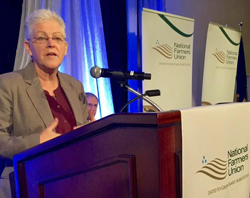The heads of both the U.S. Department of Agriculture and the Environmental Protection Agency spoke to the National Farmers Union (NFU) convention in Wichita Monday and talked about the Renewable Fuel Standard (RFS).
 EPA Administrator Gina McCarthy admitted that her agency was “in the hot seat” over the RFS after failing to set standards for the industry last year.
EPA Administrator Gina McCarthy admitted that her agency was “in the hot seat” over the RFS after failing to set standards for the industry last year.
“The RFS is a complicated program, and we weren’t able to accomplish what we needed to do last year,” she said. “Implementing the RFS as Congress intended has been challenging.”
“We need to set levels that send a longer-term message,” McCarthy continued, explaining the agency’s intention to set Renewable Volume Obligations (RVOs) for 2014, 2015, and 2016 before summer of this year.
Listen to McCarthy’s speech here, courtesy of Ken Rahjes, AgView.net. EPA Chief Gina McCarthy at 2015 NFU Convention
 Agriculture Secretary Tom Vilsack stressed his continued support for the RFS. “I love the RFS – I’m for RFS,” he said. “We need to make sure Congress doesn’t do anything to damage it or repeal it or make it difficult to use. We need to be advocates, spokespeople for this industry. We need to go out and tell folks this is the right thing to do,” he said.
Agriculture Secretary Tom Vilsack stressed his continued support for the RFS. “I love the RFS – I’m for RFS,” he said. “We need to make sure Congress doesn’t do anything to damage it or repeal it or make it difficult to use. We need to be advocates, spokespeople for this industry. We need to go out and tell folks this is the right thing to do,” he said.
Vilsack urged the crowd to continue to educate the public about the potential of weaning the nation from foreign oil imports and highlighting the potential of renewable fuels. He pointed to areas of the economy, like the military, that were converting to home grown fuels. “Navy is starting to look at renewable fuels. I am optimistic about this. We need to be advocates for this industry. We don’t want to lose this amazing marketing opportunity.”











